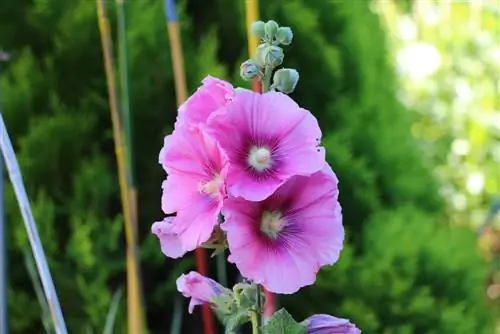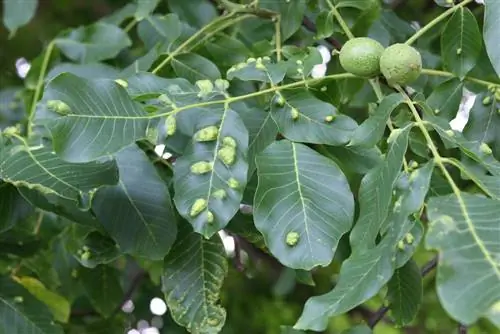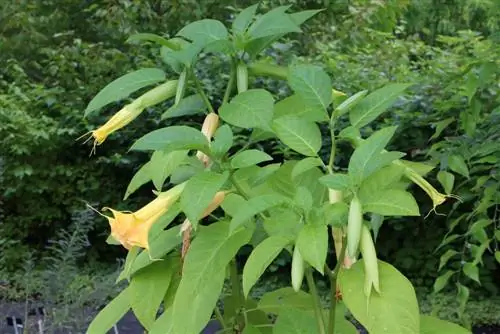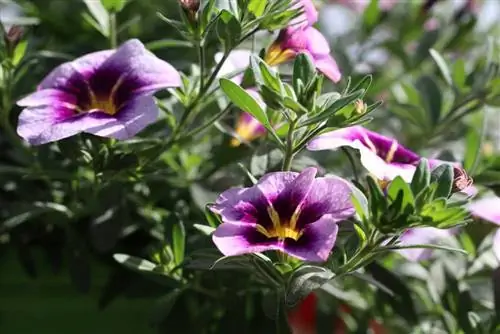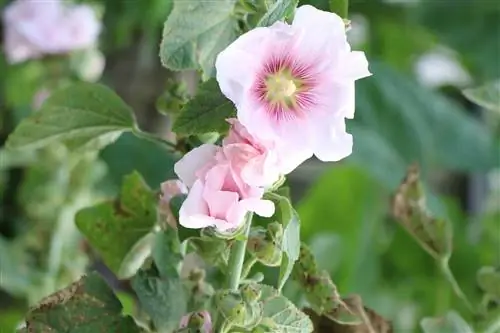- Author admin [email protected].
- Public 2023-12-17 03:39.
- Last modified 2025-01-24 12:45.
Alcea (hollyhock) was originally native to the Orient. In Central Europe it can be found in its released form on wasteland, near rubble dumps or roadsides, but also as a garden and breeding form.
Some of the approximately 60 species are very popular with home and hobby gardeners. It is a typical plant for the cottage garden.
Hollyhock disease: mallow rust
The hollyhock shows its many colorful flowers in late summer. Unfortunately, this summer splendor is often threatened by disease. The hollyhock is very susceptible to the mallow rust disease and every gardener should act quickly in this case. The plant disease is caused by a fungus (Puccinia malvearum). You can see the damage, which begins in spring, when there are almost touching yellow to brown spots on the upper side of the leaves. An orange-red to brown rash later appears on the underside of the leaves. A typical sign is the holes in the leaves. Later the leaves die and fall off. Leaves and stems can also be affected.
At the beginning of the illness, the use of a spray broth helps. To do this, mix about half a liter of compost with plenty of two liters of water. Let the porridge steep for a few days and stir daily. Filter the finished broth through a sieve and spray the plants and soil with it every three to four days. Spraying is particularly appropriate if the broth has been washed off after a rainstorm or if new leaves have grown that were not yet sprayed. Another spray mixture can be made from the plant parts of garlic, onion, field horsetail, sharps and tansy. Soak the plant parts for 24 hours, boil gently for 30 minutes and then pour them through a sieve when cool.
On the other hand, it is easier to use fungicides based on sulfur. The mushrooms thrive in wet and heavy soil, so it is advisable to loosen the soil around the hollyhock often with a hoe and fertilize it with potassium. Damp, dark corners of the garden promote the growth of fungi. Hollyhocks like an airy and sunny location anyway. If a fungal infestation is found, cutting back the affected parts vigorously also helps.
Digging up and disposing of the entire plant is the right decision if all parts are infected and you don't want the spores to spread. These must then be burned immediately or disposed of in the trash can. They must not be put on the compost heap because other garden crops can also be affected by mallow rust. This also applies to leaves that have already fallen and are lying on the ground. Dispose of these too, otherwise the fungus can overwinter on the leaves and attack the plant again next spring. To prevent fungal infestation, it helps to keep the individual plants at least 50 cm apart so that the air can flow through between them.
Wilt on hollyhocks
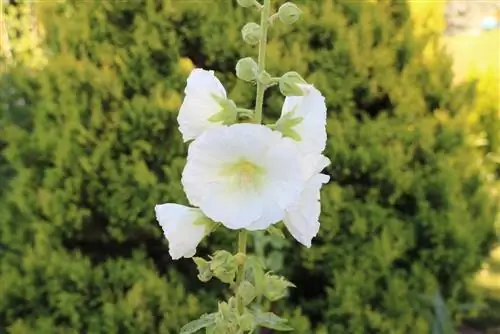
Another disease is wilt. Its cause is a disturbed water balance. A fungus destroys the water vessels within the plant. The leaves begin to wilt and then later fall off. The entire plant can be affected, including the stems. In the late stages the entire plant dies. Once the disease has been identified, the plant and its roots along with the surrounding soil should be generously dug up and destroyed. In humid summers, rust fungi can infest. The fungus does not harm the plant, but is very unsightly due to red, yellow or dark brown rust pustules.
Protect hollyhocks against pests
The hollyhock is not only very popular with hobby gardeners, but also with voracious pests such as: snails, beetles, sawflies, spider mites, lice or caterpillars. If they are still relatively rare, they are simply read. The damaged and eaten leaves are also removed. Otherwise, if the number of pests is large, insecticides must be used.
Mallow flea beetle
You can recognize the flea beetle when the leaves have many small feeding holes in the middle and the leaf vein is intact. The beetle itself is blue, green or black and has red legs. The countermeasure is to loosen the soil and water. A match stuck upside down in the ground can also help.
Mallow shrews
The beetle's trademark is its pointed proboscis and its feeding on the tips of plant shoots. It lays its eggs in the stems. The beetles appear rather rarely.
Snails
Snails sometimes cause a lot of damage to the hollyhock, especially by eating the young leaves. Spreading snail pellets or snail lentils in early spring provides relief.
Aphids
A good remedy against aphids is nettle manure. To do this, chop up fresh nettle leaves and pour rainwater into a large container, place in the sun for a few days and stir daily. The finished manure smells a bit unpleasant, but is an effective organic remedy against the creepy crawlies. It is used in a dilution of 1:10 and sprayed onto the plant in the morning. Another option is soapy water made with curd soap. Spray the insects with it and repeat several times, as not all of them will die the first time.
Conclusion
The colorful and upright growing hollyhock should not be missing in any garden. It always fits as a background plant, on the fence in front of a house wall or even as a container plant. It doesn't take long for the offspring to arrive either. The seeds almost fall out of their dry capsules on their own. The plant is easy to care for, undemanding and surprises with its abundant and colorful flowers. Planted together with white daisies and blue delphiniums, the hollyhock really comes into its own.
Tips for speed readers
Because of the long flowering period from summer to autumn, the hollyhock is a magnet for bumblebees and bees. Unfortunately, the hollyhock often suffers from mallow rust. This disease particularly occurs in summer. Mallow rust is caused by a fungus, Puccinia malvearum. The infestation can be recognized initially - in spring - by yellowish-brown spots that are clustered close together on the upper side of the leaves. On the underside of the leaf, on the other hand, there are initially white, later orange-red to brown pustules. If the infestation is severe, the leaves may die and fall off. The leaf stalks and stems can also be affected.
- You should start the fight against mallow rust when you plant the hollyhocks, because you can do a lot through prevention.
- Since mallow rust is caused by a fungus, which in turn prefers damp places, the plants should be spaced far apart so that the air can circulate well and the leaves can dry better.
- There are also preventative pesticides that are regularly applied to both the top and bottom of the leaves.
- If you still find infected leaves on the plant, they should be removed immediately and either burned or disposed of with household waste.
- Under no circumstances should the leaves remain in the garden, because not only hollyhocks can be affected by mallow rust, but also other garden plants.
- Another effective method of prevention is to cut the perennials just above the ground immediately after they have faded.
- A small amount of soil should then be piled up around the plant for protection. This will be removed again in the spring. The first 4 to 6 leaves should then be destroyed.
- If an infestation has occurred despite all preventative measures, there are chemical agents to destroy the fungus. An ecological approach is to remove and destroy the affected leaves.
Another disease that can affect hollyhocks is wilt disease. This is also caused by fungi. Depending on the type of fungus, different parts of the plant are affected. The pathogen destroys the water vessels within the plant. In most cases the plant dies. If a plant is affected by wilt disease, the entire plant and the surrounding soil should be dug up and completely destroyed.
Snails, beetles, sawflies and caterpillars can also be enthusiastic about the hollyhock. If the infestation is small, the plant pests can simply be collected. If leaves have already been damaged, they are also removed. However, if the infestation has already gotten out of hand, only the use of an insecticide often achieves the desired result.

